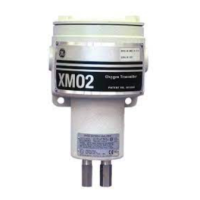Installation 2-1
September 2007
Introduction This chapter describes how to install the XMO2 transmitter and its
sample system. It also contains information on connecting optional
system components. Installation of the XMO2 system consists of
three basic steps:
1. installing the XMO2 transmitter in the sample system (If you
purchased your sample system from GE, this step has already been
done for you.)
2. mounting, plumbing, and wiring the sample system
3. making wiring connections for power input, 4-20 mA analog
output, RS232 digital output, and optional external devices
Installing the XMO2
Transmitter
Note: This section applies only if the XMO2 transmitter has not
already been installed in the sample system at the factory.
The sample system must deliver a clean, representative gas sample to
the XMO2 at the proper temperature, pressure and flow rate. This
usually means a clean, dry gas sample that is free of solid and liquid
particulates and is delivered at atmospheric pressure, a temperature
no greater than 40°C (104°F), and a flow rate of approximately 1.0
SCFH (500 cc/min). A typical sample system for the XMO2 might
include an inlet gas flow regulating needle valve, a sample gas flow
meter, and a pressure gauge.
Note: Because factory calibration of the XMO2 is done at
atmospheric pressure and at a flow rate of 1.0 SCFH,
operation of the XMO2 at other pressures and/or flow rates
requires a field recalibration to ensure optimum accuracy.
To install the XMO2 transmitter in the sample system, complete the
following steps:
1. Select a location in the sample system that provides at least 9 in.
(230 mm) of clearance above the top cover of the XMO2 for
access to the interior of the transmitter’s enclosure.
2. Mount the XMO2 transmitter in the sample system via its two
mounting holes. Be sure that the transmitter is upright and is level
to within ±15°.
3. Use 1/4” stainless steel tubing to connect the sample system Inlet
and Outlet fittings to the corresponding XMO2 ports.
!WARNING!
For explosion-proof units, be sure to conform to all
safety and electrical code requirements.

